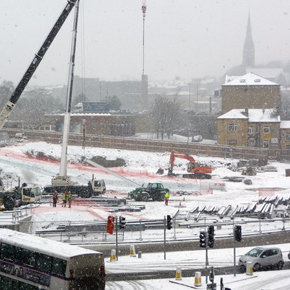
Five ways to prepare your construction site for winter
This article sees Kelly Friel, from construction specialist Zoro, share her top five tips for preparing your construction site for winter.
“With Autumn quickly coming to an end and the dark depths of winter almost upon us, conditions on construction sites are only set to get worse.
There is already a lot to take into consideration when thinking about on-site health and safety, and this will only intensify as the cold weather and dark nights bring extra challenges.
Create a plan
The winter months can create problems that only occur this time of year, so it is important to think ahead and be ready for them.
Exactly what actions need to be taken will depend on the specific workplace in question, but there are some general things to consider that are applicable across most sites.
Sit down and create a plan, taking into account key areas such as:
- Clearing roads, walkways, and workspaces
- Storing materials and equipment
- Protecting workers from the elements
- Ensuring workers are trained for winter
Be wary of ice
Slips, trips, and falls are the most common types of accidents, according to The Royal Society for the Prevention of Accidents, which will inevitably get worse in the winter.
Whether on roads, scaffolding, or walkways, ice is the single biggest risk when it comes to site safety in the winter months.
While slipping on ground level ice can cause minor injuries, slipping on scaffolding or roofing can be fatal. It is crucial workers are aware of the potential for the accumulation of ice throughout the day and don’t rely on preconceived ideas of what is safe and what is not.
Appropriate footwear, with as much traction as possible, should be worn at all times, and if conditions worsen, work could well have to be delayed or cancelled.
Reduce risk
Keeping your team safe should be number one priority and this is done by carrying out up to date risk assessments for different scenarios. The Health and Safety Executive (HSE) explains this in detail on their website.
Regular weather updates can help you plan what you’re doing in advance and react to changing conditions throughout the day.
You might also consider breaking up individual workloads in order to limit the amount of exposure of any particular worker.
Start and end of each day by surveying the construction site and assess it for new hazards, such as debris blown by wind or accumulated snow and ice.
Staying warm
It is easier to stay warm then get warm, so make sure your workers are maintaining a safe body temperature at all times.
The easiest way to get them to do this is to encourage dressing in layers, including windproof and waterproof clothing with appropriate hats and gloves.
If clothes get wet, ensure they are changed as quickly as possible — nothing lowers body temperature like being trapped in wet clothing in cold weather.
Where possible, attempt to schedule work in direct sunshine and out of wind, and always keep plenty of warm, sweet drinks on hand for a little temperature boost.
Vehicle and equipment safety
Care should always be taken with vehicles and equipment, but you’ll need to be more vigilant during the winter months.
HSE say employers should set and enforce driver safety policies and implement effective maintenance programs for all vehicles and equipment.
You must check tyre pressure, batteries, brakes, and wipers are all in good working order before using any vehicle and it is also smart to have emergency kits on hand including things like salt, torches, ice scrapers, shovels, and blankets.
Winter brings with it more challenges, but taking time to plan carefully, train workers, and implement safety measures will minimise risk and help to ensure a problem-free construction site.
Latest news

19th April 2024
ASSA ABLOY: Access solutions can impact sustainability performance across the full life-cycle of a building
Embedding sustainability within any organisation requires a broad, strategic perspective. Scrutiny should include the physical infrastructure itself: According to the IEA, buildings consume around 30% of global energy*. ASSA ABLOY has more…
Posted in Access Control & Door Entry Systems, Architectural Ironmongery, Articles, Building Industry News, Building Products & Structures, Building Regulations & Accreditations, Building Services, Case Studies, Doors, Facility Management & Building Services, Information Technology, Research & Materials Testing, Retrofit & Renovation, Security and Fire Protection, Sustainability & Energy Efficiency, Video of the Week
19th April 2024
British weather doesn't dampen spirit for new HMG Garden Paint
Despite one of the wettest starts to the year on record, customers are starting to plan for brighter days with HydroPro Garden Paint from HMG Paints.
Posted in Articles, Building Industry News, Building Products & Structures, Garden, Innovations & New Products, Paints, Paints, Coatings & Finishes, Restoration & Refurbishment, Retrofit & Renovation, Site Preparation, Sustainability & Energy Efficiency, Waste Management & Recycling
18th April 2024
Abloy UK showcases new digital portfolio at The Security Event 2024
Abloy UK is set to unveil its latest line-up of access control systems at The Security Event 2024, welcoming guests to explore its cutting-edge electromechanical and digital solutions on stand 5/F50.
Posted in Access Control & Door Entry Systems, Architectural Ironmongery, Articles, Building Industry Events, Building Industry News, Building Products & Structures, Building Services, Doors, Exhibitions and Conferences, Facility Management & Building Services, Health & Safety, Information Technology, Retrofit & Renovation, Security and Fire Protection
18th April 2024
Strand is a Failsafe Choice for Emergency Exit and Panic Hardware
In times of emergency, you’re in safe hands with Strand Hardware. Although there are many considerations for building specification, few decisions can be as critical as selecting the right emergency exit/panic hardware.
Posted in Access Control & Door Entry Systems, Architectural Ironmongery, Articles, Building Industry News, Building Products & Structures, Building Services, Doors, Facility Management & Building Services, Health & Safety, Restoration & Refurbishment, Retrofit & Renovation, Security and Fire Protection
 Sign up:
Sign up: